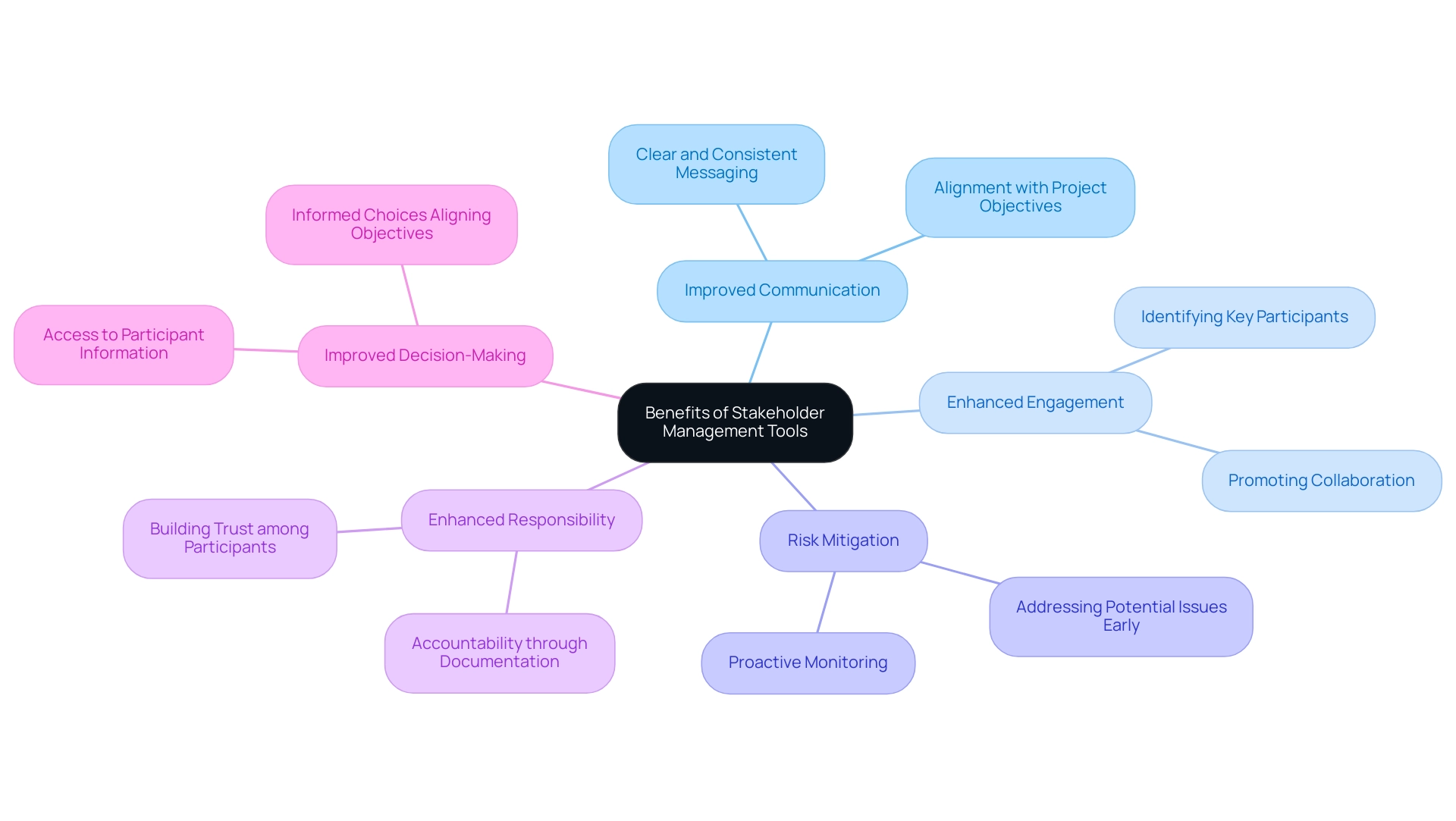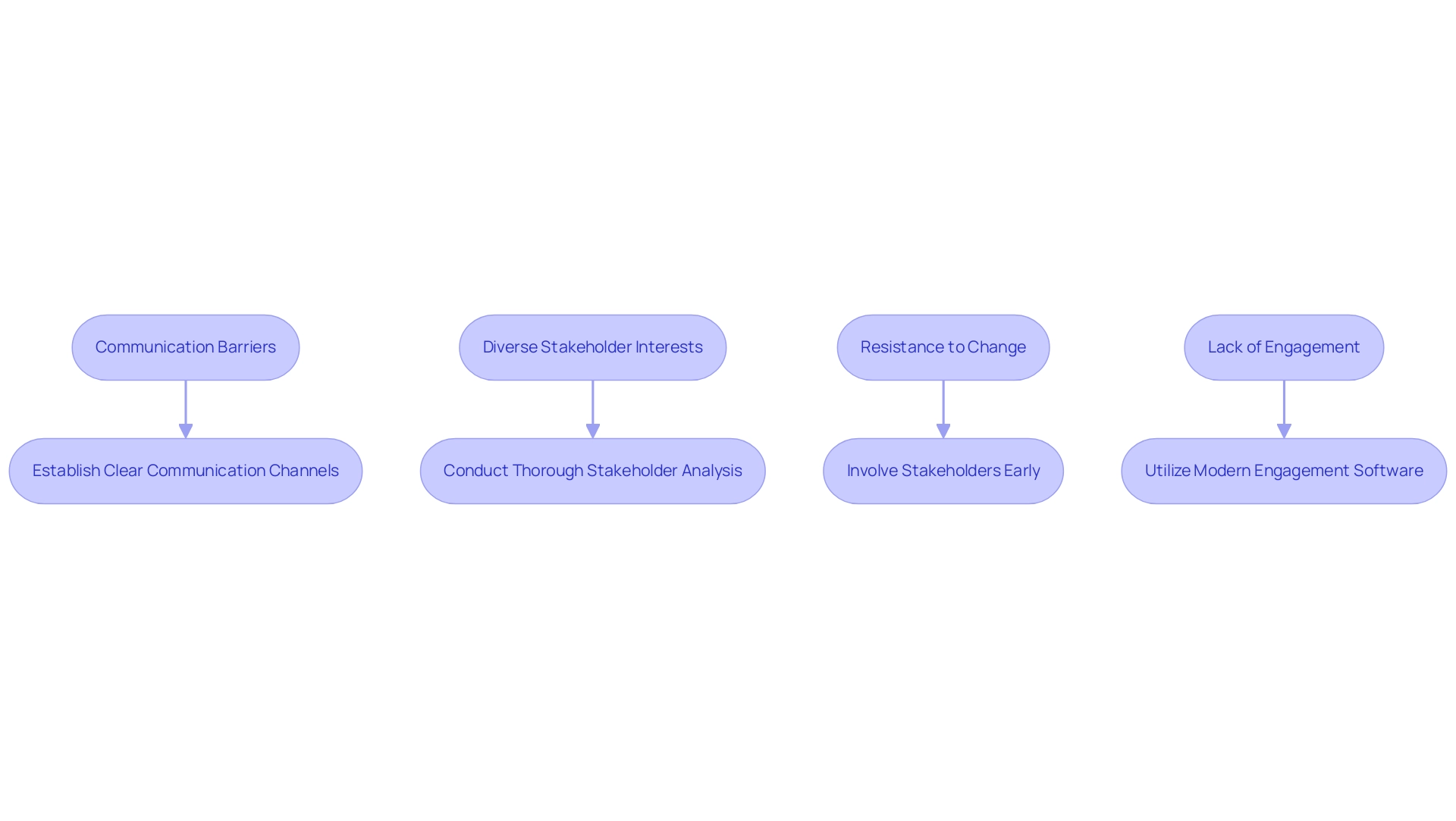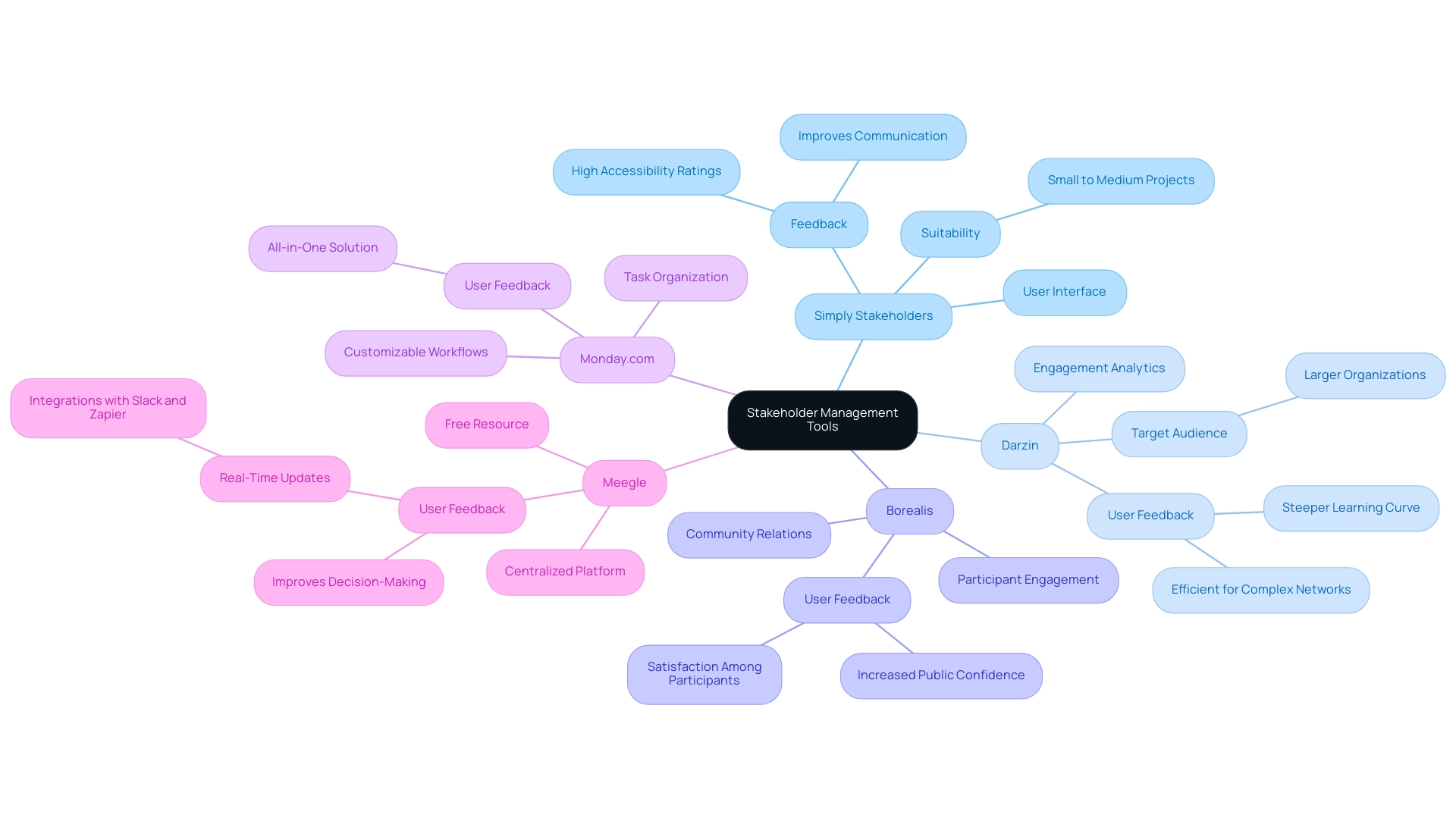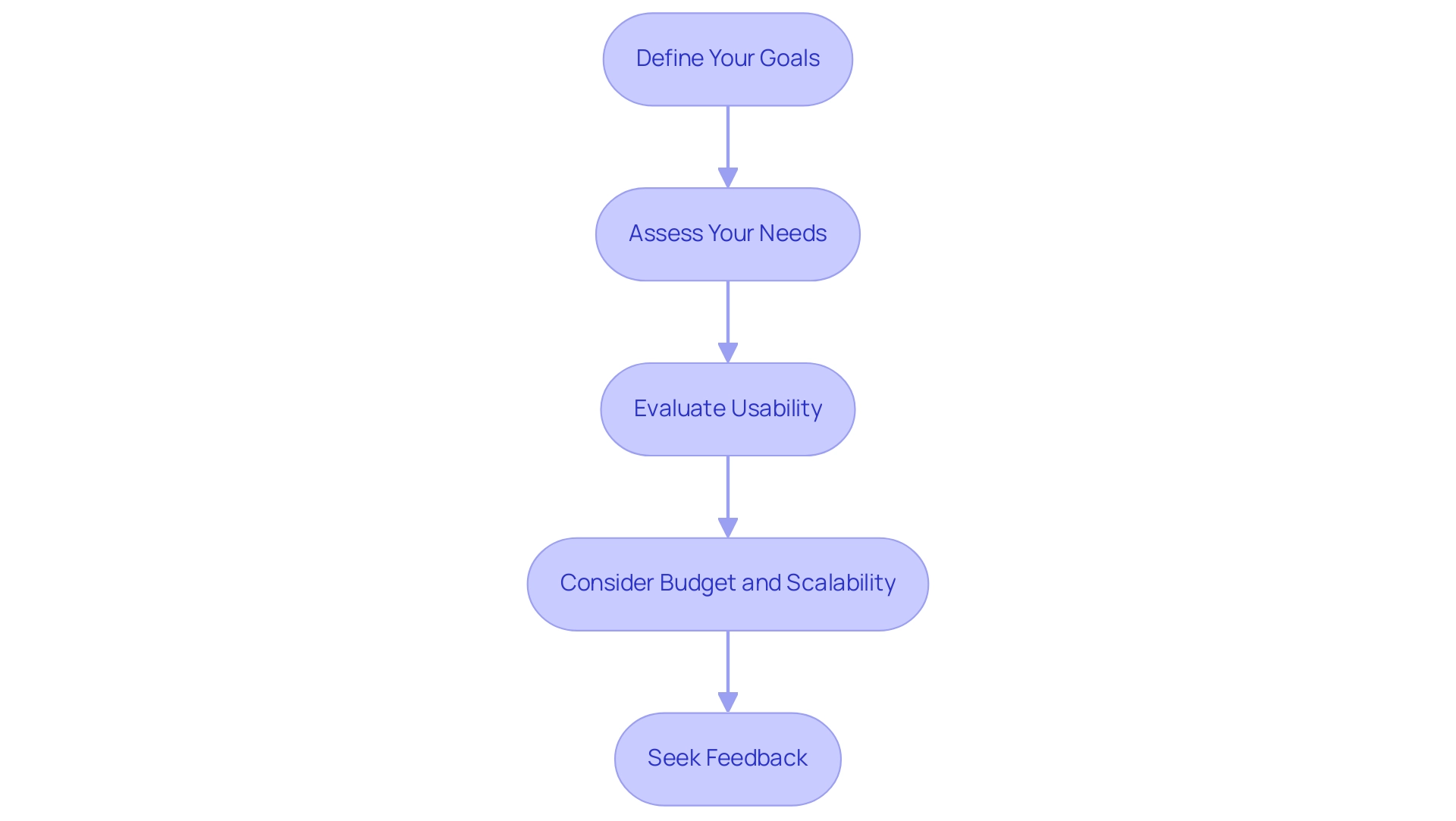Overview
This article provides a comprehensive comparison of various stakeholder management tools, emphasizing their features and benefits to aid organizations in selecting the most suitable option for their specific needs. It details different types of tools, including:
- CRM systems
- Specialized software
It also underscores the critical role of:
- Effective communication
- Engagement analytics
- Usability
in enhancing project outcomes and fostering strong stakeholder relationships.
Introduction
In today's increasingly interconnected business landscape, effective stakeholder management stands as a cornerstone of project success. Organizations are increasingly turning to specialized tools to navigate the complexities of stakeholder relationships, ensuring clear communication and alignment throughout the project lifecycle. From advanced software solutions that enhance engagement analytics to simple yet effective spreadsheets, the variety of stakeholder management tools available today caters to diverse organizational needs.
As companies grapple with the financial implications of mismanaged stakeholder trust, understanding the features and benefits of these tools becomes essential for fostering collaboration and driving project outcomes. This comprehensive exploration delves into the different types of stakeholder management tools, their key functionalities, and the strategies organizations can employ to select the right solution for their unique challenges.
Understanding Stakeholder Management Tools: An Overview
Resources, including tools for stakeholder management, are essential for organizations aiming to efficiently recognize, assess, and communicate with their constituents. These resources enhance communication, monitor interactions, and manage expectations throughout the project lifecycle, ensuring that all parties remain aligned and informed. This alignment is particularly critical in high-stakes environments, where miscommunication can result in significant setbacks.
For example, research shows that three global companies with a market capitalization exceeding US $10 billion suffered a staggering loss of 20% to 56% in value due to a breach of trust among involved parties, highlighting the financial implications of ineffective management of these relationships.
Modern management software has emerged as vital tools for stakeholder management, simplifying analysis and relationship management. These resources not only improve communication but also provide insights into participant sentiments, enabling organizations to proactively address concerns and build trust. A notable trend is the increasing adoption of technology-enabled solutions that facilitate real-time engagement and feedback, essential for navigating complex dynamics.
However, while AI technologies such as ChatGPT can support relationship engagement, the fundamental elements of interaction still rely heavily on human emotional intelligence, indicating a limited role for AI in this domain.
Practical examples illustrate the effectiveness of these resources in enhancing outcomes. Entities that have implemented report higher levels of participant satisfaction and project success rates. In crisis scenarios, effective resources for engaging parties have proven their value, allowing organizations to swiftly identify and address issues, thereby mitigating potential harm.
Challenges such as resistance to change, differing interests, and insufficient resources can be effectively addressed through acknowledgment, negotiation, and dedicated efforts, further underscoring the importance of these resources.
Expert opinions emphasize the necessity of continuous investment in training and resources for engaging with involved parties. Notably, 83% of high-achieving organizations, referred to as 'Champions,' prioritize such investments, recognizing that robust engagement with involved parties is a cornerstone of success. By linking these investments to the benefits of engagement resources, organizations can gain a clearer understanding of how to achieve success in their endeavors.
As the landscape of participant oversight evolves, staying informed about the latest resources and strategies is vital for organizations striving to thrive in today's competitive environment.
Types of Stakeholder Management Tools: A Comprehensive Guide
can be classified into several key categories, each designed to meet varying needs based on project complexity and stakeholder engagement levels:
- Spreadsheets: Essential resources that enable organizations to monitor participant information and interactions in a straightforward manner. Although economical and commonly utilized, their constraints in scalability and collaboration can impede more intricate oversight efforts.
- CRM Systems: Customer Relationship Management tools are vital for managing relationships and communications. They provide a centralized platform for tracking interactions, managing contact information, and analyzing engagement metrics. Significantly, CRM systems possess a considerable market portion in overseeing relationships, demonstrating their efficacy in cultivating strong connections. For instance, ClickUp Brain is available on all paid plans for $7/month per user, making it a cost-effective option for organizations.
- Task Coordination Software: Tools like Asana and Trello not only aid in tracking tasks but also incorporate features for participant oversight. This dual functionality enables teams to track participant engagement alongside task management, improving overall visibility and accountability. Furthermore, coordination software such as Omegle can connect with these project oversight applications, highlighting the significance of monitoring involvement alongside tasks and workflows.
- Specialized Stakeholder Management Software: Dedicated platforms like Simply Stakeholders and Darzin provide advanced features for mapping and engaging with involved parties. These tools for stakeholder management are created to specifically address the subtleties of managing interests, allowing organizations to customize their strategies effectively. A case study titled "Critical Participant Segments: Tailoring Engagement Strategies" illustrates the effectiveness of categorizing individuals based on their unique characteristics and contributions, which can significantly enhance the effectiveness of engagement efforts.
Each variety of instrument serves unique functions, and the selection among them should be directed by the particular needs of the undertaking and the preferred level of participant involvement. For instance, the urgency of developing fast strategies for engaging involved parties is underscored by the fact that 39% of social media users want quick responses. By utilizing the appropriate resources, organizations can enhance contributor involvement and propel initiative success.
Moreover, organizations keen on improving participant involvement can schedule a demo to examine the platform's features and capabilities.
Key Features to Look for in Stakeholder Management Tools
When evaluating stakeholder management tools, several key features emerge as essential for optimizing project outcomes:
- Stakeholder Mapping: This feature enables users to visualize the relationships and influence dynamics among stakeholders, facilitating a clearer understanding of their roles and impacts on projects.
- Communication Tracking: Effective tools meticulously record interactions and communications with involved parties, ensuring that all engagements are documented and accessible for future reference.
- Engagement Analytics: Insights into participant engagement levels and sentiment are crucial. These analytics assist in pinpointing areas of concern and opportunities for deeper engagement, ultimately boosting success.
- Reporting Capabilities: The capacity to produce detailed reports on participant interactions and progress is essential for ensuring transparency and accountability.
- Integration with Other Tools: Compatibility with existing task organization and CRM systems streamlines workflows, enhancing efficiency and collaboration across teams.
These characteristics are not merely advantageous; they serve as essential tools for stakeholder management and effective oversight of involved parties. Recent findings indicate that organizations utilizing stakeholder management tools experience a notable enhancement in project communication and overall success rates. Significantly, , such as revenue growth rate and net profit margin, underscore the importance of efficient relationship handling in achieving financial success.
As Maddy McGannon, Controller at Simple Mills, noted, "This is another way that MineralTree has helped us increase user productivity, even for employees who may not work in AP." Moreover, Deloitte's 'CFO Signals' survey emphasizes the growing acknowledgment among finance executives of the economic possibilities of advanced technologies, reinforcing the case for incorporating engagement resources into financial operations. As CFOs increasingly recognize this transformative potential, leveraging these resources can lead to sustainable growth and improved outcomes.
Benefits of Implementing Stakeholder Management Tools in Projects
Applying management resources offers numerous benefits that significantly aid in achieving success. Key benefits include:
- Improved Communication: These tools facilitate clear and consistent communication with stakeholders, minimizing misunderstandings and ensuring that all parties are aligned with project objectives.
- Enhanced Engagement: By identifying and engaging key participants, organizations can promote collaboration and obtain essential support, which is vital for initiative advancement.
- Risk Mitigation: Proactively monitoring the sentiments and expectations of involved parties enables organizations to tackle potential issues before they intensify, thereby lessening risks related to execution.
- Enhanced Responsibility: The use of tools for stakeholder management creates a clear record of interactions, ensuring accountability and building trust among participants.
- Improved Decision-Making: Access to extensive participant information enables organizations to make informed choices that align objectives with interests, ultimately enhancing results.
Moreover, incorporating real-time analytics into the management of involved parties not only streamlines decision-making but also allows organizations to continually monitor business performance. This approach enables teams to take decisive actions swiftly, preserving business health during critical turnaround phases. Studies show that firms that actively interact with their constituents perform 15% better in their strategic initiatives, with involved participants contributing to an impressive 78% success rate.
This is backed by the case study named "Measuring Stakeholder Engagement Effectiveness," which emphasizes the significance of clear evaluation systems and proactive involvement in improving organizational agility and results. In addition, enhancing participant engagement techniques is crucial for business success, as it results in stronger relationships, increased sales, and improved risk handling. CFOs have observed that efficient tools for stakeholder management not only enhance communication but also refine decision-making processes, resulting in more successful implementation of initiatives.
By utilizing these resources, organizations such as can greatly improve their engagement strategies with interested parties, leading to improved outcomes and promoting sustainable growth.

Integrating Stakeholder Management Tools with Project Management Methodologies
Incorporating tools for stakeholder management alongside methodologies such as Agile, Waterfall, or PRINCE2 is imperative for enhancing results. Agile endeavors, characterized by iterative development and ongoing feedback, require resources that facilitate real-time communication and feedback loops. These instruments can be seamlessly integrated into Agile sprints, ensuring that participant needs are consistently met and aligned with objectives.
Conversely, Waterfall methodologies, defined by their sequential stages, benefit from resources that provide extensive participant mapping and comprehensive communication strategies. Tools for stakeholder management play a crucial role in maintaining alignment throughout the initiative lifecycle, ensuring that all participants are informed and engaged at each stage. This proactive approach transforms stakeholder engagement from a mere afterthought into a vital component of planning and execution, particularly when utilizing stakeholder management tools.
Statistics reveal that 71% of professionals overseeing initiatives have noted an increase in the use of collaboration software within their organizations over the past year, underscoring the growing recognition of the significance of effective engagement with stakeholders. Moreover, a case study entitled 'Communication in Management' highlights the necessity of establishing clear communication pathways and involving departmental representatives, which significantly enhances the effectiveness of stakeholder management tools and participant satisfaction.
Furthermore, Wellingtone indicates that 79% of organizations employ , emphasizing the need for adequate training for key participants. Notably, while 58% of organizations recognize the importance of initiative oversight, only 33% of IT endeavors succeed due to insufficient leadership participation. This underscores the essential role of leadership in achieving successful stakeholder engagement.
As the demand for skilled program leaders continues to escalate, with approximately 88 million individuals expected to occupy oversight roles by 2027, it becomes increasingly critical to integrate tools for stakeholder management with participant engagement tools across both Agile and Waterfall methodologies. By fostering a culture of collaboration and responsiveness, organizations can ultimately enhance their success rates.
Common Challenges in Stakeholder Management and How to Overcome Them
Efficient management of interested parties is paramount for overcoming obstacles that can significantly influence the success of an initiative. The following key issues must be addressed:
- Communication Barriers: Miscommunication often leads to misunderstandings that can derail projects. As notes, managing involved parties presents numerous challenges, including communication gaps that lead to misunderstandings and evolving expectations. To mitigate this, organizations should establish clear communication channels and implement regular updates to ensure all parties are informed and aligned.
- Diverse Stakeholder Interests: Stakeholders frequently have conflicting interests, complicating objectives. Conducting a thorough analysis of involved parties is essential to understand their varying needs and identify common ground that facilitates collaboration. Statistics suggest that organizations are anticipated to continue advancing their analysis journey in 2023, acknowledging the essential role it plays in success.
- Resistance to Change: Stakeholders may exhibit resistance to new initiatives, stemming from fear of the unknown or perceived threats to their interests. Involving interested parties early in the process and addressing their concerns can foster buy-in and reduce resistance.
- Lack of Engagement: Disengaged participants can hinder project progress. Utilizing modern engagement software, which organizations are increasingly adopting as tools for stakeholder management, can help track engagement levels and tailor communication strategies to effectively re-engage these individuals.
Addressing these challenges is essential for improving participant coordination efforts. For instance, a case study titled "Stakeholder Turnover and Change" highlights the importance of monitoring changes and maintaining comprehensive documentation to ensure smooth transitions in roles and responsibilities. As organizations continue to navigate these complexities, utilizing tools for stakeholder management within technology-enabled consulting services can provide tailored solutions that meet distinct participant needs.
By concentrating on these approaches, organizations can enhance their relationships with interested parties and promote the success of initiatives.

Comparative Analysis of Leading Stakeholder Management Tools
In this comparative analysis, we explore several prominent management resources, each providing unique features designed for diverse organizational requirements:
- Simply Stakeholders: Renowned for its intuitive user interface, Simply Stakeholders excels in mapping and engagement tracking. It is particularly well-suited for small to medium-sized projects, allowing teams to visualize relationships and interactions effectively. User feedback emphasizes its simplicity, with many commending its capacity to facilitate communication and improve collaboration.
- Darzin: This resource distinguishes itself with its sophisticated engagement analytics and , making it perfect for larger organizations that handle intricate networks of interest. Darzin's robust features enable users to analyze engagement patterns and outcomes, providing valuable insights for strategic decision-making. Users have observed its efficiency in handling various interest groups, although some have highlighted a steeper learning curve in relation to simpler tools.
- Borealis: Designed for the public sector, Borealis emphasizes participant engagement, community relations, and feedback handling. It provides specialized resources that facilitate transparent communication and encourage community involvement. Entities using Borealis have indicated greater satisfaction among involved parties and increased public confidence, showcasing its efficiency in overseeing community-focused initiatives.
- Monday.com: As a flexible platform for organizing tasks, Monday.com incorporates features for managing involved parties within a wider framework. This makes it an excellent choice for teams seeking an all-in-one solution. Its customizable workflows and visual task tracking capabilities enable organizations to manage interactions with interested parties alongside other responsibilities seamlessly.
- Meegle: Marketed as a free resource, Meegle assists organizations in adopting a structured approach to managing interested individuals. It tackles the challenges organizations encounter with fragmented communication and undefined roles in managing multiple tasks. Meegle offers a centralized platform for monitoring participant engagement and improving decision-making, fostering collaboration through customizable workflows and real-time updates via integrations with applications like Slack and Zapier.
Each of these applications has distinct advantages, and the best selection depends on the particular needs of the organization. For medium-sized businesses, the balance between functionality and user-friendliness is crucial. Tools for stakeholder management, like Simply Stakeholders and Darzin, provide customized solutions that can greatly improve engagement and success of initiatives.
Regarding user satisfaction, Simply Stakeholders has received high ratings for its accessibility and effectiveness in small initiatives, while Darzin's advanced features have garnered praise from users managing larger, more intricate engagement environments. Comparative statistics suggest that organizations utilizing these resources experience enhanced communication and collaboration, ultimately resulting in more successful outcomes. Real-world examples demonstrate the practical applications of these resources.
For example, Simply Stakeholders has been effectively used in small-scale initiatives to improve engagement with interested parties, while Darzin has proven invaluable for organizations navigating complex interest landscapes. Moreover, the recent funding declaration by PCORI highlights the significance of participant engagement in research strategies, emphasizing the relevance of these resources in contemporary settings. Expert evaluations consistently emphasize the significance of choosing a resource that corresponds with the organization's particular engagement requirements, ensuring that the selected solution promotes effective participation and drives project success.
As Sean R Tunis observed, the suggested definitions and conceptual framework of participant engagement provide a foundation for researchers and sponsors to prioritize, design, and execute effective engagement strategies.

Choosing the Right Stakeholder Management Tool for Your Organization
Selecting the appropriate stakeholder management tool is a critical process that necessitates careful consideration of several essential factors:
- Define Your Goals: Begin by articulating clear objectives for your stakeholder management efforts. Comprehending your goals is essential for directing your equipment selection.
- Assess Your Needs: Evaluate the scope of your project, the complexities of relationship dynamics, and the specific functionalities you require from the resource. This assessment ensures that the chosen solution aligns with your organizational context. As highlighted in the case study "," categorizing stakeholders into groups based on their voice and value can enhance engagement strategies.
- Evaluate Usability: Prioritize resources that are intuitive and user-friendly. A seamless adoption by your team is crucial for maximizing effectiveness and ensuring consistent engagement.
- Consider Budget and Scalability: It is vital to select an option that not only fits within your budget constraints but also offers scalability to accommodate your organization's growth. Organizations with efficient engagement strategies are 40% more likely to finish tasks punctually and within budget, highlighting the significance of this factor. This statistic reinforces the need for careful budget planning in equipment selection.
- Seek Feedback: Involve team members in the selection process to gather diverse insights regarding their preferences and needs. This collaborative approach can lead to a more informed decision and greater buy-in from the team.
By carefully assessing these elements, organizations can select tools for stakeholder management that not only enhance their engagement strategies but also significantly contribute to project success. Furthermore, incorporating real-time analytics into your partner engagement strategy allows for continuous business performance monitoring, enabling teams to make informed decisions swiftly. Metrics on communication quality, task completion rates, and participant satisfaction are essential for evaluating the return on investment (ROI) of engagement initiatives, ensuring that the chosen resource provides tangible benefits.
As Derek S Drew observes, "These findings assist in elucidating what the highly prioritized factors are, and could also serve as an evaluation tool to assess the performance of participant oversight and thus aid in identifying areas for enhancement." Transform Your Small/ Medium Business employs these strategies to ensure effective stakeholder management, facilitating a streamlined decision-making process that is essential during turnaround situations.

Conclusion
Effective stakeholder management transcends mere best practice; it is a vital element for achieving project success in today’s intricate business landscape. A thorough exploration of various stakeholder management tools unveils a broad array of solutions, ranging from basic spreadsheets to sophisticated software specifically designed for stakeholder engagement. Each tool presents unique functionalities tailored to meet diverse organizational needs, ensuring that communication remains clear and stakeholders stay engaged throughout the project lifecycle.
Key features such as stakeholder mapping, communication tracking, and engagement analytics emerge as critical for optimizing project outcomes. Organizations that actively implement these tools not only enhance their communication and collaboration efforts but also mitigate risks and improve decision-making processes. Moreover, the integration of stakeholder management tools with established project management methodologies further underscores their significance, enabling teams to effectively align stakeholder interests with project goals.
Despite the inherent challenges in stakeholder management—such as communication barriers and varying stakeholder interests—the right tools can equip organizations with the insights necessary to navigate these complexities. By investing in appropriate stakeholder management solutions, organizations can cultivate stronger relationships, enhance stakeholder satisfaction, and ultimately drive project success.
In conclusion, the strategic selection and implementation of stakeholder management tools exemplify an organization’s commitment to collaboration and transparency. As stakeholder dynamics continue to evolve, staying informed about the latest tools and practices will empower organizations to thrive in an increasingly interconnected landscape. By prioritizing effective stakeholder engagement, organizations can not only safeguard their project outcomes but also lay a foundation for sustainable growth and success.
Frequently Asked Questions
Why are resources for stakeholder management essential for organizations?
Resources for stakeholder management are essential because they help organizations efficiently recognize, assess, and communicate with their constituents, enhancing communication, monitoring interactions, and managing expectations throughout the project lifecycle.
What are the financial implications of ineffective stakeholder management?
Ineffective stakeholder management can lead to significant financial losses, as illustrated by three global companies that suffered a 20% to 56% loss in market value due to a breach of trust among involved parties.
How do modern management software tools assist in stakeholder management?
Modern management software tools simplify analysis and relationship management, improve communication, provide insights into participant sentiments, and enable organizations to proactively address concerns and build trust.
What role does technology play in stakeholder engagement?
Technology-enabled solutions facilitate real-time engagement and feedback, which are essential for navigating complex dynamics in stakeholder relationships.
What is the limitation of AI technologies in stakeholder management?
While AI technologies like ChatGPT can support relationship engagement, the fundamental elements of interaction still rely heavily on human emotional intelligence, indicating a limited role for AI.
How do comprehensive participant coordination systems impact project success?
Organizations that implement comprehensive participant coordination systems report higher levels of participant satisfaction and project success rates, especially in crisis scenarios where effective engagement resources help swiftly identify and address issues.
What challenges can arise in stakeholder management, and how can they be addressed?
Challenges such as resistance to change, differing interests, and insufficient resources can be addressed through acknowledgment, negotiation, and dedicated efforts.
What do expert opinions suggest regarding investment in stakeholder engagement resources?
Expert opinions emphasize the necessity of continuous investment in training and resources for engaging with involved parties, with 83% of high-achieving organizations prioritizing such investments.
What types of tools are available for stakeholder management?
Stakeholder management tools include: 1. Spreadsheets for monitoring participant information, 2. CRM Systems for managing relationships and communications, 3. Task Coordination Software for tracking tasks and participant engagement, 4. Specialized Stakeholder Management Software for advanced mapping and engagement.
How should organizations select the appropriate stakeholder management tools?
Organizations should select tools based on the specific needs of the project and the desired level of participant involvement, ensuring they can effectively enhance contributor engagement and drive initiative success.




